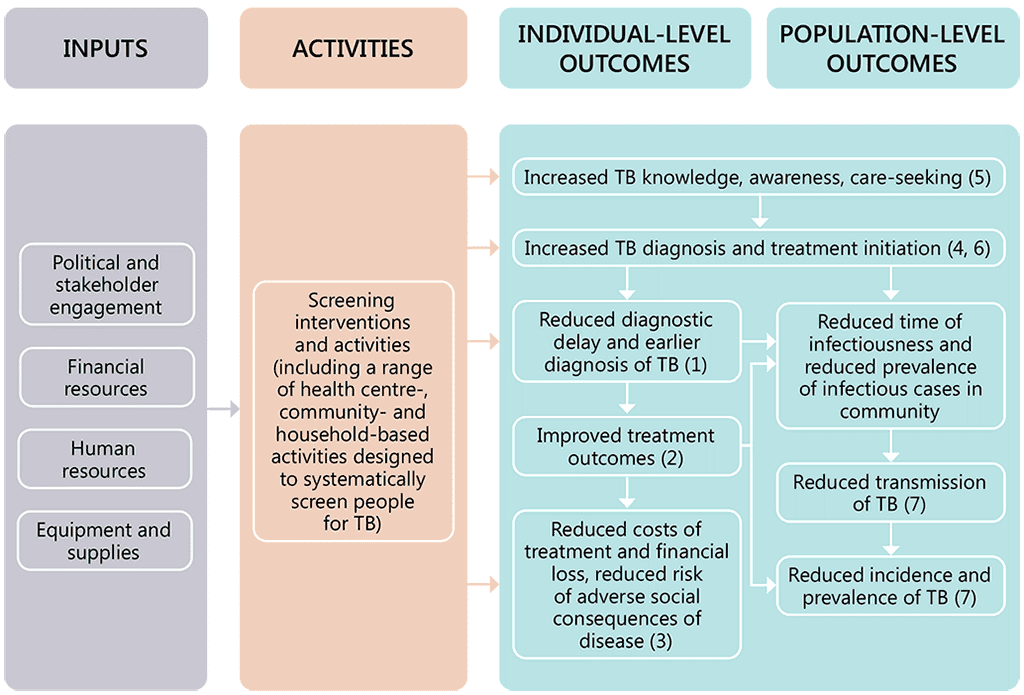كتاب روابط اجتياز لـ 1266
Fig.1 summarizes the potential contribution of TB screening to standard TB care practices based on the above frameworks for TB screening and shows the conceptual framework that guided the 2021 update to the TB screening guidelines.
Fig. 1. Conceptual framework for the 2021 WHO update to guidelines for systematic screening for TB. Numbers in parentheses refer to the PICO (population, intervention, comparator and outcome) questions that guided the evidence gathering

A series of PICO (population, intervention, comparator and outcome) questions was established and systematic reviews were sought or commissioned for each of the PICO questions and the priority background questions.
The first PICO questions aimed at summarizing the evidence on the effectiveness of systematic screening interventions for TB disease to address individual and community outcomes.
1. Among people with TB disease, does TB screening identify people at an earlier stage of disease compared with passive case-finding?
2. Is there a difference in TB treatment outcomes between people with TB identified through screening interventions compared with people with TB identified through passive case-finding?
3. For people with TB disease and their families, does receiving a diagnosis and undergoing a course of treatment after case detection through screening have a different cost of illness and risk of adverse social consequences compared with receiving a diagnosis and undergoing a course of treatment after diagnosis through passive case-finding?
4. For people being screened who do not have TB disease, what are the consequences of TB screening?
5. Does TB screening used in addition to passive case-finding affect subsequent health-seeking behaviour compared with passive case-finding alone?
6. Does TB screening initially increase the number of people with TB detected compared with passive case-finding alone?
7. Does TB screening affect the epidemiology of TB in a community, including the prevalence, incidence and transmission, compared with passive case-finding alone?
A series of questions focusing on the diagnostic accuracy and performance of screening tools was also prioritized.
8. Among people living with HIV, what is the performance of a range of screening tools compared with a microbiological reference standard?
9. Among the general population and high-risk groups eligible for TB screening, what is the performance of a range of screening tools compared with a microbiological reference standard?
10. Among children and adolescents eligible for TB screening, what is the performance of a range of screening tools compared with a composite or microbiological reference standard?
11. What is the performance of computer-aided detection (CAD) software for automated reading of digital chest radiographs (CXRs) for the detection of TB disease in the screening- and the triageuse cases?
12. Among the general population and high-risk groups eligible for TB screening, what is the performance of molecular WHO-recommended rapid diagnostic tests (mWRDs) for screening for TB disease compared with a microbiological reference standard?
Lastly, in addition to the PICO questions assessing the accuracy and effectiveness of screening interventions, there was a series of background questions prioritized to inform the implementation of TB screening interventions.
13. Among the general public and high-risk populations, what is the number needed to screen (NNS) to detect one person with TB disease?
14. Among contacts of people with TB disease, what is the NNS to detect one person with TB disease?
15. What are the estimated relative risks of TB associated with a range of risk factors?
16. What are the costs and cost–effectiveness of implementing TB screening interventions?
17. What are the perceptions and attitudes of communities towards TB screening programmes?

 تعليق
تعليق